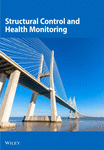Optimal performance of discrete-time direct output-feedback structural control with delayed control forces
Abstract
An optimal discrete-time direct output-feedback control algorithm is developed with the consideration of sampling period and appropriate time delay in its control force action. Optimal-delayed output-feedback gains are derived through a variation process and will be complementarily arranged with respect to the applied delay time by either altering their magnitude or phases to assure the efficacy and stability of the delayed direct digital control system. Parametric studies of single-degree-of-freedom (SDOF) systems with different feedback types demonstrate the relationships of the delayed gains and the modal properties corresponding to the sampling period used and the intentionally delay time added. The maximum allowable delay time defined at the onset of instability of controlled system can be the optimal delay time that reaches the optimal control performance if the delay time is considered in the delayed feedback gains. The inclusion of sampling period and delay time in the optimization process for discrete-time control illustrates the beneficial effect under the same delay time. Numerical simulation results of proposed direct digital control principles on a three-degree-of-freedom (3DOF) shaking table structure model show that the efficacy of the collocated control cases with optimal delay time to reduce the dynamic responses subjected to earthquake excitations is assured. Copyright © 2007 John Wiley & Sons, Ltd.




